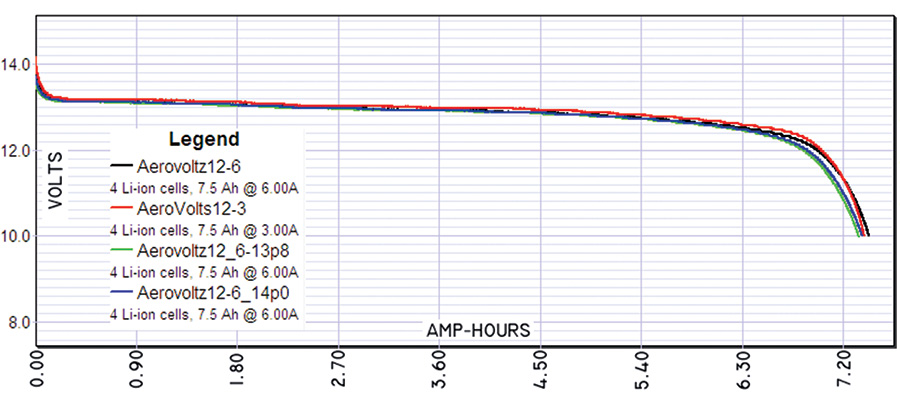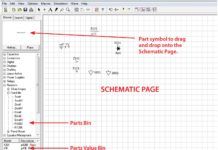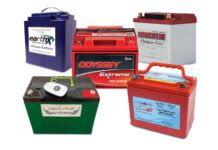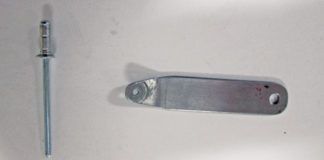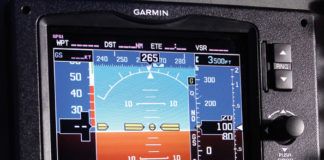A few days ago one of my readers volunteered his new Aerovoltz 12-cell Model EV02 lithium ion battery for detailed examination of performance on the bench (hat tip: Matt Stecher). I want to make it clear that this article is not intended to champion or discourage a switch to lithium batteries. Nor is it intended to paint Aerovoltz with a black, sticky brush. This article will illustrate the thought processes for evaluating battery performance, integrating the battery into an aircraft electrical system, and offer guidance for all wannabe manufacturers of aircraft batteries as to how their product’s performance influences the designer/builder’s buy decision.
The Aerovoltz 12 appears to be fabricated from three parallel strings of four cells each. The battery data makes no claim for an internal battery management system (BMS). This product does feature a multi-pin connector for attaching an Aerovoltz proprietary battery-charger/cell-balancing accessory. The physical size of the “silos” suggests that core components for this battery are cells conforming to the industry standard 26650 form factor. (See aerovoltz.com.) An exemplar cell offered by A123 Systems is described in this data sheet. Data for most cells in this form factor cite a capacity on the order of 2.5Ah. Some examples cite capacities of 4.0Ah or more! These claims seem exaggerated… I will acquire some of these cells for further examination.
The web site and printed literature for this battery calls for charging voltages not to exceed 14.4V. It cautions against discharge below 9.0V. It states that batteries discharged to 6.0V or less are considered trash. The literature also cites a cold cranking rating of 410A.
The Tests
I first applied a constant current, constant voltage charger set for 14.4V/3A to the battery. I observed an initial charge current of 3A that tapered to less than 0.1A in about 15 minutes. In other words, the battery was nearly topped off as received. A load test at 400A produced a terminal voltage of about 8V. I topped the battery off again before discharging it at 3A constant current until the terminal voltage dropped to 10V.
The first discharge cycle demonstrated 7.3 Ah of capacity as shown by the red plot in the chart. A third 14.4V top-off and 6A load produced nearly the same capacity (shown in black). Subsequent tests were conducted at 6 Amps after top-offs at 14.0V (blue) and 13.8V (green).
Similarities in this family of plots is interesting. You will recall plots for lead-acid products depicted in prior articles illustrated considerable “spread” in useful capacity over a range of test loads. Discharge plots for lead-acid showed ever-increasing loss of energy to internal heating as battery loads are increased. The four plots in the chart suggest that (1) internal losses in this battery are quite low, (2) adjustment of the charging voltage over 13.8V to 14.4V produced no significant change in the battery’s stored energy, and (3) my original guess for a 3×4 array of 2.5Ah cells was accurate. A 400A load test was repeated after one last top-off. Again, the battery’s terminal voltage dropped to about 8.0V.
The four plots suggest that (1) internal losses in this battery are quite low, (2) adjustment of the charging voltage over 13.8V to 14.4V produces no significant change in the battery’s stored energy, and (3) the author’s original guess for a 3×4 array of 2.5Ah cells is accurate.
Interpretation
- In terms of alternator-inop endurance, the Aerovoltz 12 will support a 6A load for just over one hour when new (consistent with a 3×4 array of 2.4Ah cells), and just under one hour at end of life. These tests suggest that the Aerovoltz 12 battery at end of life is a 5A energy source for one hour. It follows that this battery will support a 1.25A load in a four-hour endurance mode at end of life.
- The manufacturer’s claim for 400A of “cold cranking” ability is suspect. The legacy cranking test calls for loading a battery until its terminal voltage drops to 9.0V. Load current is modulated as necessary to maintain 9.0V. Read cranking current at the end of 15 seconds. When this test article was loaded to 400A at room temperature, it dropped immediately to 8.0V. It would drop still lower at cold temperatures, hence my assertion that the test article did not deliver to the published specifications.
- The ‘lead-acid equivalency’ of this product in aviation terms is nowhere near that claimed in published data. For example: A review of published data from Hawker-Enersys on the Odyssey series batteries reveals that the PC535 will support a 6A load for about two hours when new and 1.6 hours at end of life…a little better than the 1.2H/0.95H of an Aerovoltz 12.
- Room temperature cranking abilities of the two batteries are on a par with each other. So in aviation terms I would have to say that the Aerovoltz 12 is not quite equivalent to the PC535, which is rated at 13Ah at a 10-hour rate.
- The PC535 weighs in at about 12 pounds, so substituting an Aerovoltz 12 will save you about 11.5 pounds.
System Integration
- These test data suggest that the legacy 13.0V calibration point for low voltage warning is probably too low. The lead-acid battery delivers energy at 12.5V and below, while the bus voltage for charging is maintained at 14.2V to 14.6V. The lithium product delivers energy at 13.2V and below, while wanting to be charged at no more than 14.4V. The band between alternator-operating and alternator-inop is much tighter, and it’s centered at about 13.8 volts. The narrow span between normal bus voltage and battery-only ops voltage may drive a requirement for tighter tolerances in the low-volts warning set-point.
- The alternator regulator set-point may need tighter control. Few regulators are adjustable. No built-in regulators are adjustable.
- Legacy over-voltage indication and shut-down philosophies may need further study. If sustained operation over 14.4V is deleterious to the battery, then an OV protection device might be crafted to allow operation over 14.4V for a minute or so before tripping off line…operation above 15V might call for trip after 100 mS.
- The Aerovoltz products are fitted with maintenance connectors. The manufacturer claims that battery life will be improved if the battery is charged with their proprietary balancing charger. Most vehicles, including our airplanes, are cranked and parked with a topped-off battery. If a smart charger is necessary to maintain or restore a battery’s internal order, it follows that a prudent preventative maintenance protocol would call for capacity checks (deep discharge to 10V) followed by a cell-balancing recharge under command and control of a smart charger. Just how often this procedure should be conducted is not yet known.
Conclusion
These tests were conducted gently and well within parameters suggested by the manufacturer’s published limits on a reader’s brand-new battery. I wanted to return the battery none the worst for wear. I have some individual cells on order that will be subjects of more aggressive studies.
I hope this brief peek into the life and times of an exemplar lithium battery demonstrates that the popular “lead-acid equivalency” numbers are meaningless to the aircraft systems integrator. It’s important to note that published marketing data for most, if not all, lithium products falls short of what’s necessary for well-considered system design and operations. If your chemically stored energy design goals call for battery-only endurance equal to or better than fuel endurance, then the choice of batteries must include an evaluation of contained energy balanced against design goals—irrespective of your choice in chemistries or battery architectures. This study also illustrates the need for careful consideration for the small, but significant differences in performance between lithium and lead technologies. Those “little differences” may have a profound influence upon return-on-investment for making the lead-to-lithium switch.
Fly comfortably…


